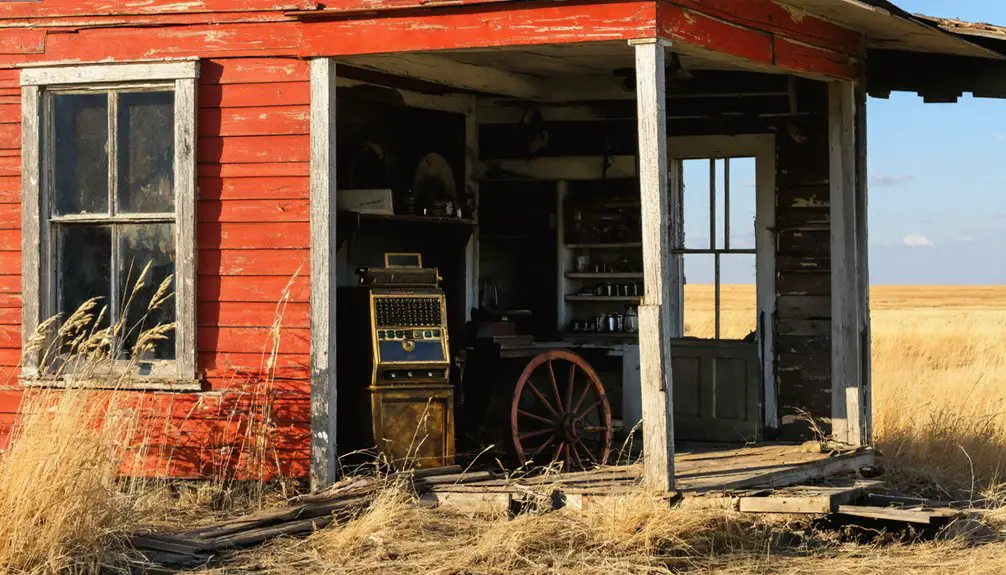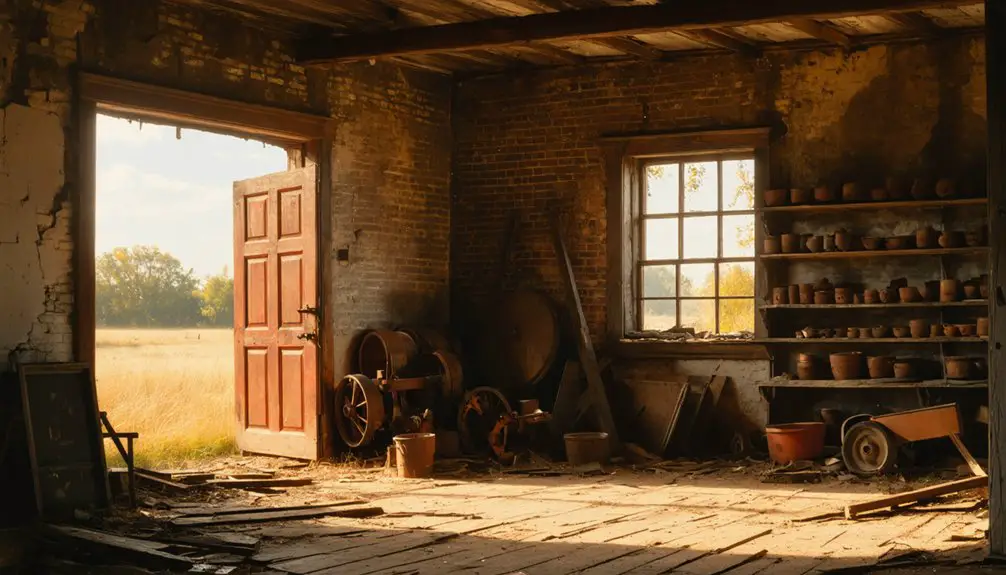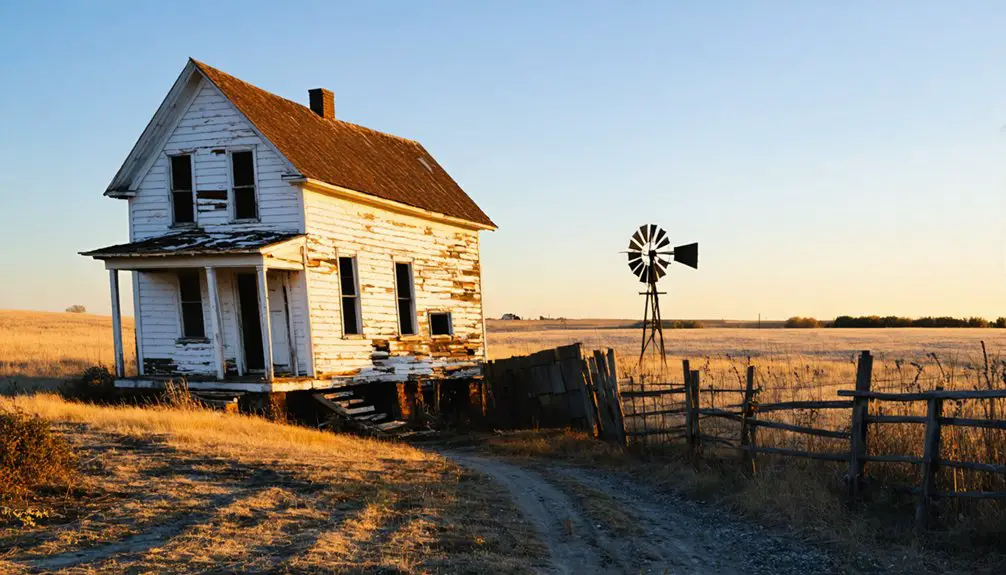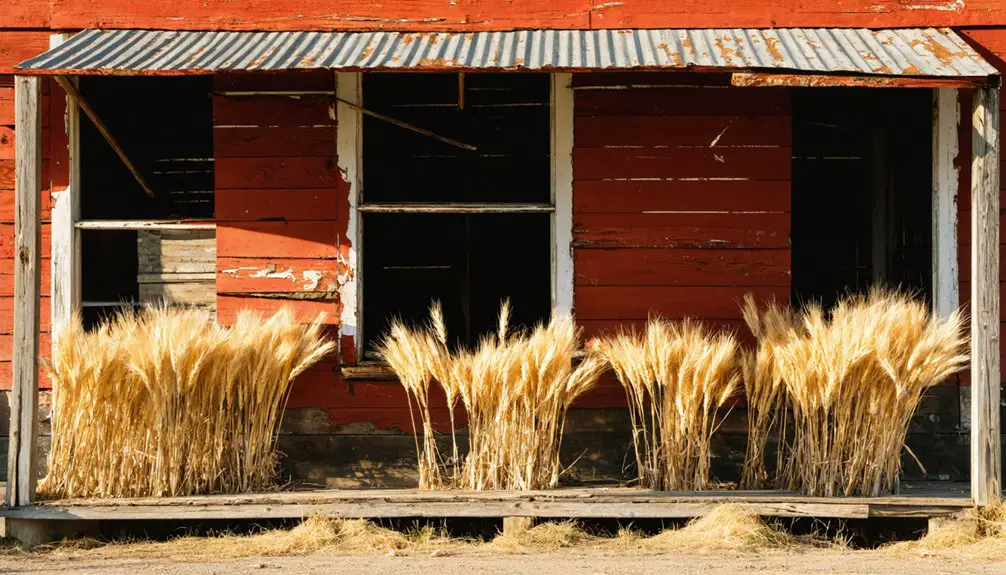You’ll find Terra Cotta’s ghost town remains along the former Kansas Pacific Railway line, where it emerged in 1878 as a clay mining and cattle shipping hub. Thomas Mullen and S.M. Simpson established this boomtown, capitalizing on rich Dakota Formation deposits and expanding stockyards. The town thrived until 1887 when a devastating wildfire sparked its decline, leading to the post office’s closure by 1913. Terra Cotta’s story echoes through preserved artifacts and historical records.
Key Takeaways
- Terra Cotta was established in 1878 along the Kansas Pacific Railway as a clay and sand shipping point before becoming a ghost town.
- The town thrived as a major livestock shipping center by 1885, featuring stockyards between Kansas City and Denver.
- A devastating wildfire in 1887 destroyed the hotel, leading to population decline from 75 residents to 20 by 1910.
- The post office permanently closed in 1913, marking the final decline of Terra Cotta as an active community.
- Historical preservation includes the relocation of the original depot to Ellsworth’s museum complex and community-led ghost town tours.
The Birth of a Railway Boomtown
Two ambitious entrepreneurs, Thomas Mullen and S.M. Simpson, established Terra Cotta in 1878, strategically positioning it along the Kansas Pacific Railway line.
You’ll find the town’s origins at Mullen’s Siding, where the railway significance became apparent through its role as a crucial shipping point for clay and sand.
The boomtown dynamics took shape quickly as Terra Cotta’s location offered key advantages.
You’re looking at a site blessed with accessible water and timber, essential resources that attracted settlers.
This prime settlement offered pioneers the lifeblood of frontier success: flowing water and abundant timber for building their dreams.
Monroe Loomis served as the town’s first postmaster while helping establish the growing community.
The town’s name, meaning “colored earth” in Italian, reflected the abundant red clay deposits in the surrounding area. The local clay was ideal for creating baked earth sculptures and pottery, similar to ancient civilizations.
With the post office opening on July 2, 1878, Terra Cotta marked its official beginning as a railway boomtown, ready to capitalize on Kansas’s emerging transportation network.
Clay and Sand: Natural Resources That Shaped Terra Cotta
The rich geological makeup of Terra Cotta’s landscape proved central to its development, with the Dakota Formation housing valuable clay and sand deposits that would define the town’s identity.
You’ll find these resources embedded within the formation’s distinctive layers, where clay utilization and sandstone extraction became the cornerstone of local industry. The formation’s gray and red mottled clay characterized the Terra Cotta member’s composition.
The area’s natural wealth reveals itself through:
- Extensive beds of kaolinite and montmorillonite clays, perfect for brick-making
- Interbedded sandstone layers formed by ancient rivers and shorelines
- Rich deposits approximately 100 feet below the formation’s top, ideal for mining
These deposits weren’t just abundant – they were high-quality.
The clay’s unique mineral composition, featuring calcium and potassium-rich structures, made it particularly valuable for construction materials, while the varied sandstone grades offered versatile building options. The area’s geological history shows that during the Early Cretaceous period, a brief marine invasion deposited the valuable Kiowa Shale.
From Spring Creek Station to Railroad Hub
You’ll find the origins of Terra Cotta at Spring Creek Station, established in 1859 along the Butterfield Overland Despatch route about 1.5 miles west of the future town.
The arrival of the Kansas Pacific Railroad in 1867 brought Thomas Mullen’s strategic purchase of nearby land, where he established Mullen’s Siding as a shipping point for clay and sand. Like other Home Stations along the route, Spring Creek provided meals and overnight lodging to weary travelers before the railroad’s arrival.
The railroad transformed the area from a simple stagecoach stop into a bustling hub, leading to the formal establishment of Terra Cotta in 1878 by Thomas Mullen and S.M. Simpson.
Early Stage Station Days
Located along the historic Butterfield Overland Despatch route, Spring Creek Stage Station emerged in 1859 as an important stagecoach stop approximately 1.5 miles west of what would become Terra Cotta.
If you’d visited during the height of stagecoach operations, you’d have witnessed the convergence of pioneers, mail carriers, and early settlers at this critical waypoint.
At this strategic location, now near the junction of K-140 and K-141 highways, you would’ve seen:
- Weary travelers resting between long stretches of the Smoky Hill Trail
- Stagecoach drivers changing horses and replenishing supplies
- Mail carriers exchanging essential correspondence between frontier settlements
The area’s rich deposits of terra cotta clay made it a notable location in eastern Ellsworth County.
The station continued serving travelers until 1870, when changing transportation needs brought an end to its operations.
Today, no physical remnants of this frontier outpost remain.
Rail Transforms Terra Cotta
When Kansas Pacific Railroad laid tracks through Mullen’s Siding in 1867, it transformed a simple clay and sand shipping point into what would become Terra Cotta. The railroad expansion replaced the area’s former role as Spring Creek Station, shifting from stagecoach transport to rail-based commerce.
You’ll find that Terra Cotta’s economic transformation took shape quickly after the tracks were laid. By 1878, the formally platted townsite attracted entrepreneurs who established a grocery, elevator, lumber yard, and hotel. Like the finest depot on the line in Sedalia, Terra Cotta’s railway facilities became a source of local pride.
The railroad’s diagonal route through Mullen’s quarter section made shipping viable, turning Terra Cotta into a significant cattle shipping hub between Kansas City and Denver. By 1885, the stockyards were flourishing, and the town had grown from a mere siding to a village of 75 inhabitants.
The Golden Age of Cattle Shipping
During the post-Civil War era, Kansas emerged as the epicenter of America’s cattle shipping industry, transforming frontier towns into bustling commercial hubs. Contract drovers handled the majority of cattle drives during this period, charging $1 to $1.50 per head.
You’d find massive cattle drives heading north from Texas, drawn by powerful economic incentives – beef prices were ten times higher in eastern cities than in Texas. Joseph McCoy‘s vision turned Abilene into a strategic shipping powerhouse, where the Kansas Pacific Railroad enthusiastically facilitated the movement of livestock. The industry proved highly speculative, with many experiencing financial boom and bust as cattle markets fluctuated dramatically.
Consider the scale of this operation:
- A typical drive moved 3,000 cattle with 10 cowboys
- Each cowboy managed three horses over the two-month journey
- Crews covered 15 miles daily to maintain cattle weight
Between 1867 and 1884, over five million cattle thundered along the Chisholm Trail through Kansas railheads, fueling an unprecedented beef bonanza that connected western ranches to eastern markets.
Life in a 19th Century Kansas Trading Post

Life at a Kansas trading post revolved around three essential functions: commerce, community gathering, and cultural exchange.
You’d find trading post essentials like coffee, hardtack biscuits, and cast iron pots stacked alongside beaver-felt hats and silver ornaments. The air would be thick with the scent of animal hides, while dim lantern light illuminated the rough-hewn walls where barter systems thrived between settlers and Native Americans. The Hudson Bay Company established numerous trading posts that became vital supply points across the frontier.
You’d witness complex relationships unfold as traders exchanged goods with Osage and Dakota tribes, offering everything from gunpowder to blankets for precious furs.
Despite the isolation and harsh conditions, these posts became crucial social hubs where you could gather news, collect mail, or seek shelter from the wilderness. They weren’t just supply stations – they were lifelines in the vast Kansas frontier.
The Economic Engine of Terra Cotta
You’ll find Terra Cotta’s economic story inextricably linked to the Kansas Pacific Railway, which enabled the town’s transformation into a major livestock center in 1885.
The strategic location and newly built stockyards quickly established Terra Cotta as the region’s premier cattle shipping point, surpassing all locations between Kansas City and Denver from 1886 to 1912.
Your journey through Terra Cotta’s peak economic period would have revealed a bustling hub where stockyards, a grain elevator, and crucial businesses served the steady stream of cattle moving through this essential transportation nexus.
Railroad Drives Town Growth
The Kansas Pacific Railroad shaped Terra Cotta’s destiny when the original Mullen’s Siding was established in 1867, attracting a small settlement of 15-20 people near the diagonal rail line.
The railroad’s impact transformed this Kansas prairie location into a bustling hub of commerce, with town infrastructure growing rapidly around the crucial transportation corridor.
You’ll find Terra Cotta’s growth was directly tied to these key railroad developments:
- Multiple stockyards emerged by 1885, making it a major cattle shipping point between Kansas City and Denver
- A new Union Pacific depot was constructed in 1900, cementing the town’s shipping importance
- Essential businesses sprouted up, including a grocery store, grain elevator, lumber yard, hotel, cheese factory, and blacksmith shop
The rail line’s presence enabled Terra Cotta to thrive as a significant shipping point for local agriculture and livestock.
Cattle Shipping Hub Flourishes
During the late 1800s, Terra Cotta emerged as a powerhouse in cattle shipping, outperforming its neighbor Brookville by a three-to-one margin and establishing itself as the premier livestock transport hub between Kansas City and Denver.
You’d find a bustling cattle economy that transformed this small town of 75 residents into a crucial link in America’s livestock industry. The shipping infrastructure included extensive stockyards where ranchers could gather their herds before transport.
Local businesses thrived, with a cheese factory, blacksmith shop, grocery store, elevator, lumber yard, and hotel serving the growing community. The town’s strategic location made it irresistible to cattle operators seeking efficient transport routes.
Terra Cotta’s dominance in the region’s cattle trade created numerous jobs and opportunities for enterprising residents who sought their fortune in the livestock business.
Notable Pioneers and Town Builders

Notable pioneers shaped Terra Cotta’s emergence as a thriving railway town, beginning with Thomas Mullen’s arrival from Illinois in 1867. Mullen’s pioneering spirit led him to establish a clay and sand shipping business, creating Mullen’s Siding which attracted early settlers. His partnership with S.M. Simpson in 1878 launched Terra Cotta’s formal development.
The town’s rapid growth came through key pioneer contributions:
- Monroe Loomis and his brother Frank built essential commercial structures including a grocery store, elevator, and hotel.
- Thomas Mullen leveraged the Kansas Pacific Railroad’s presence to establish crucial shipping operations.
- S.M. Simpson helped position the town as a commerce hub before selling his interest to Connecticut investors.
These visionary town builders transformed Terra Cotta from prairie grassland into a bustling railway community serving farmers and ranchers throughout the region.
Legacy of the Butterfield Overland Despatch
You’ll find that Terra Cotta’s stage station served as a crucial link in the Butterfield Overland Despatch‘s ambitious 592-mile route connecting Atchison to Denver.
The station, strategically positioned along the Smoky Hill Trail, operated as one of the “swing stations” where drivers could quickly change horses while signaling their arrival with brass bugles.
The BOD’s presence in Terra Cotta during 1865-1866 established the town as a key transport hub until railroad expansion ultimately made the stagecoach route obsolete.
Stage Station Origins
In 1865, the Butterfield Overland Despatch established an essential transportation network through Terra Cotta, Kansas, as part of its ambitious 592-mile route between Atchison and Denver.
As you explore Terra Cotta’s history, you’ll discover how this stage coach stop became crucial for freight transport along the Smoky Hill Trail.
The station’s strategic layout included:
- A home station offering meals, lodging, and blacksmith services for weary travelers
- Stables for quick horse changes during the tri-weekly express service
- Telegraph facilities connecting this frontier outpost to major cities
The station’s location was carefully chosen after thorough engineering surveys, positioning it roughly 12 miles from neighboring stops.
You can still imagine the sound of brass bugles announcing incoming coaches as station staff prepared for their arrival.
Strategic Transport Route
While Terra Cotta’s stage station initially served local needs, the arrival of the Butterfield Overland Despatch in 1865 transformed it into a significant link along the shortest freight route between Atchison and Denver.
You’ll find it was part of the pioneering transportation networks that shaved 61 miles off the traditional Platte River path, following an ancient Native American trail along the Smoky Hill River.
The station’s historical significance grew as it supported the tri-weekly stagecoach service that began September 11, 1865.
As one of many stations positioned 12 miles apart, it provided essential horse changes and rest stops for travelers.
The route’s strategic importance prompted military protection from nearby forts, though Native American attacks remained a constant challenge along this critical corridor to Colorado’s goldfields.
The Path to Abandonment

Despite its promising start as a bustling shipping hub along the Kansas Pacific Railway, Terra Cotta’s path to abandonment began with a devastating wildfire in 1887 that destroyed the town’s hotel.
A thriving railway town’s decline began with a single spark, as wildfire claimed Terra Cotta’s hotel in 1887.
Economic challenges followed swiftly, triggering an exodus of families and businesses from the area.
You can trace the town’s decline through these stark milestones:
- Population plummeted from 75 residents at its peak to just 20 people by 1910
- The post office closed its doors permanently in 1913
- All structures eventually vanished, leaving only railroad tracks as evidence of Terra Cotta’s existence
Today, if you visit Terra Cotta’s former location in Ellsworth County, you won’t find the once-thriving cattle shipping point.
The town’s transformation into a ghost town stands as a reminder of the frontier’s unpredictable nature.
Preserving Terra Cotta’s Place in Kansas History
Although Terra Cotta’s physical presence has largely vanished, dedicated preservation efforts keep its historical legacy alive through multiple channels.
You’ll find the town’s story preserved through historical documentation including post office logs, school records, and detailed cattle shipping data from 1886 to 1912. The original depot now stands in Ellsworth’s museum complex, offering tangible connection to this once-thriving hub.
Community engagement continues through local historical societies, ghost town tours, and digital archives. You can explore Terra Cotta’s past through museum exhibits, university research projects, and public lectures.
While the original hotel, grocery store, and other structures are gone, historical records and genealogical data help reconstruct life in this former railway stop, where 75 residents once called home.
Frequently Asked Questions
What Was the Average Property Value in Terra Cotta During Its Peak?
You’ll find property trends suggest values ranged from $1.25 to $5 per acre for farmland, while commercial lots near the railway commanded higher prices during the town’s historical economy peak.
Did Any Famous Outlaws or Historical Figures Ever Pass Through Terra Cotta?
Peculiarly, there’s no proof that prominent outlaws or historical figures ever visited. While you’d hope for exciting outlaw sightings or historical rumors, no documented evidence shows famous individuals passed through during Terra Cotta’s peak.
What Were the Common Diseases and Medical Challenges in Terra Cotta?
You’d have faced respiratory infections, tuberculosis, and typhoid as major disease outbreaks, while lacking proper medical practices since there weren’t any permanent facilities – just traveling doctors for treatment.
Were There Any Major Fires or Natural Disasters in Terra Cotta?
You’ll find only one major fire incident: the 1887 wildfire that destroyed the town’s hotel. Historical records don’t show any other significant natural disasters impacting Terra Cotta’s development or decline.
What Indigenous Tribes Lived in the Terra Cotta Area Before Settlement?
You’ll find the Kansa tribe was the primary Native tribe in this area, with the Pawnee, Wichita, and Osage peoples also sharing the cultural heritage of these ancestral lands.
References
- https://legendsofkansas.com/terra-cotta-kansas/
- https://en.wikipedia.org/wiki/Terra_Cotta
- https://lostkansas.ccrsdigitalprojects.com/sites/lostkansas/files/private_static/2023-07/SLSKT_EW_TerraCotta_Hall.pdf
- https://kids.kiddle.co/Terra_Cotta
- https://en.wikipedia.org/wiki/List_of_ghost_towns_in_Kansas
- http://www.rrshs.org/Kansas/ellsworth.htm
- https://pubs.geoscienceworld.org/books/book/chapter-pdf/966614/spe287-0079.pdf
- https://www.kgs.ku.edu/Publications/Bulletins/109_10/03_occur.html
- https://www.kgs.ku.edu/General/Geology/Clay/04_geol.html
- https://dnr.mo.gov/document-search/clay-shale-pub2905/pub2905



